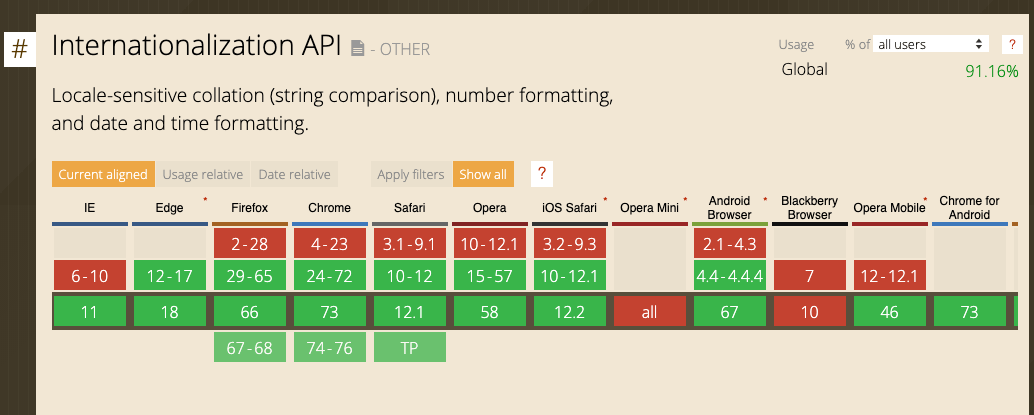JavaScript Internationalization
New Course Coming Soon:
Get Really Good at Git
Learn how to work with internationalization in JavaScript
Intl is a powerful object that exposes the JavaScript Internationalization API.
It exposes the following properties:
Intl.Collator: gives you access to language-sensitive string comparisonIntl.DateTimeFormat: gives you access to language-sensitive date and time formattingIntl.NumberFormat: gives you access to language-sensitive number formattingIntl.PluralRules: gives you access to language-sensitive plural formatting and plural language rulesIntl.RelativeTimeFormat: gives you access to language-sensitive relative time formatting
It also provides one method: Intl.getCanonicalLocales().
Intl.getCanonicalLocales() lets you check if a locale is valid, and returns the correct formatting for it. It can accept a string, or an array:
Intl.getCanonicalLocales('it-it') //[ 'it-IT' ]
Intl.getCanonicalLocales(['en-us', 'en-gb']) //[ 'en-US', 'en-GB' ]
and throws an error if the locale is invalid
Intl.getCanonicalLocales('it_it') //RangeError: Invalid language tag: it_it
which you can catch with a try/catch block.
Different types can interface with the Intl API for their specific needs. In particular we can mention:
String.prototype.localeCompare()Number.prototype.toLocaleString()Date.prototype.toLocaleString()Date.prototype.toLocaleDateString()Date.prototype.toLocaleTimeString()
Let’s go and see how to work with the above Intl properties:
Intl.Collator
This property gives you access to language-sensitive string comparison
You initialize a Collator object using new Intl.Collator(), passing it a locale, and you use its compare() method which returns a positive value if the first argument comes after the second one. A negative if it’s the reverse, and zero if it’s the same value:
const collator = new Intl.Collator('it-IT')
collator.compare('a', 'c') //a negative value
collator.compare('c', 'b') //a positive value
We can use it to order arrays of characters, for example.
Intl.DateTimeFormat
This property gives you access to language-sensitive date and time formatting.
You initialize a DateTimeFormat object using new Intl.DateTimeFormat(), passing it a locale, and then you pass it a date to format it as that locale prefers:
const date = new Date()
let dateTimeFormatter = new Intl.DateTimeFormat('it-IT')
dateTimeFormatter.format(date) //27/1/2019
dateTimeFormatter = new Intl.DateTimeFormat('en-GB')
dateTimeFormatter.format(date) //27/01/2019
dateTimeFormatter = new Intl.DateTimeFormat('en-US')
dateTimeFormatter.format(date) //1/27/2019
The formatToParts() method returns an array with all the date parts:
const date = new Date()
const dateTimeFormatter = new Intl.DateTimeFormat('en-US')
dateTimeFormatter.formatToParts(date)
/*
[ { type: 'month', value: '1' },
{ type: 'literal', value: '/' },
{ type: 'day', value: '27' },
{ type: 'literal', value: '/' },
{ type: 'year', value: '2019' } ]
*/
You can print the time as well. Check all the options you can use on MDN.
Intl.NumberFormat
This property gives you access to language-sensitive number formatting. You can use it to format a number as a currency value.
Say you have a number like 10, and it represents the price of something.
You want to transform it to $10,00.
If the number has more than 3 digits however it should be displayed differently, for example, 1000 should be displayed as $1.000,00
This is in USD, however.
Different countries have different conventions to display values.
JavaScript makes it very easy for us with the ECMAScript Internationalization API, a relatively recent browser API that provides a lot of internationalization features, like dates and time formatting.
It is very well supported:

const formatter = new Intl.NumberFormat('en-US', {
style: 'currency',
currency: 'USD',
minimumFractionDigits: 2
})
formatter.format(1000) // "$1,000.00"
formatter.format(10) // "$10.00"
formatter.format(123233000) // "$123,233,000.00"
The minimumFractionDigits property sets the fraction part to be always at least 2 digits. You can check which other parameters you can use in the NumberFormat MDN page.
This example creates a number formatter for the Euro currency, for the Italian country:
const formatter = new Intl.NumberFormat('it-IT', {
style: 'currency',
currency: 'EUR'
})
Intl.PluralRules
This property gives you access to language-sensitive plural formatting and plural language rules. I found the example on the Google Developers portal by Mathias Bynens the only one I could relate to practical usage: giving a suffix to ordered numbers: 0th, 1st, 2nd, 3rd, 4th, 5th..
const pr = new Intl.PluralRules('en-US', {
type: 'ordinal'
})
pr.select(0) //other
pr.select(1) //one
pr.select(2) //two
pr.select(3) //few
pr.select(4) //other
pr.select(10) //other
pr.select(22) //two
Every time we got other, we translate that to th. If we have one, we use st. For two we use nd. few gets rd.
We can use an object to create an associative array:
const suffixes = {
'one': 'st',
'two': 'nd',
'few': 'rd',
'other': 'th'
}
and we do a formatting function to reference the value in the object, and we return a string containing the original number, and its suffix:
const format = (number) => `${number}${suffixes[pr.select(number)]}`
Now we can use it like this:
format(0) //0th
format(1) //1st
format(2) //2nd
format(3) //3rd
format(4) //4th
format(21) //21st
format(22) //22nd
Note that there are nice things coming soon to Intl, like Intl.RelativeTimeFormat and Intl.ListFormat, which are at the time of writing only available in Chrome and Opera.


Here is how can I help you:
- COURSES where I teach everything I know
- THE VALLEY OF CODE your web development manual
- BOOTCAMP 2024 cohort in progress, next edition in 2025
- BOOKS 16 coding ebooks you can download for free on JS Python C PHP and lots more
- SOLO LAB everything I know about running a lifestyle business as a solopreneur
- Interesting links collection
- Follow me on X